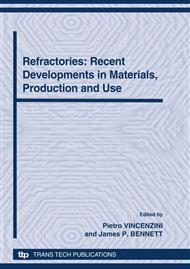p.53
p.59
p.65
p.72
p.82
p.91
p.102
p.108
p.114
Microtexture Control of Alumina Using Anisotropic Alumina Particles
Abstract:
A dense alumina body with anisotropic grains was fabricated from anisotropic particles (platelets) after heating at 1650°C for 15 min under applying pressure of 60 MPa using a PECS technique. When the alumina was cut on the vertical plane to the load direction while sintering, the breakdown voltage was 15 KV/mm and thermal conductivity was 36 W/mK. On the other hand, a porous alumina body was also synthesized from alumina platelets. The uniaxial pressure in fabricating the green compact body had an influence on the relative density of the alumina body after heating. The relative density and compressive strength of the compact that was uniaxially pressed at 1 MPa were 75 %, respectively. In addition, the relative density and compressive strength of compact that was uniaxially pressed at 3 MPa were 64 %, respectively. The thermal conductivity of the porous alumina with 64% in porosity was 0.8 W/Km.
Info:
Periodical:
Pages:
82-90
Citation:
Online since:
October 2010
Price:
Сopyright:
© 2010 Trans Tech Publications Ltd. All Rights Reserved
Share:
Citation:


